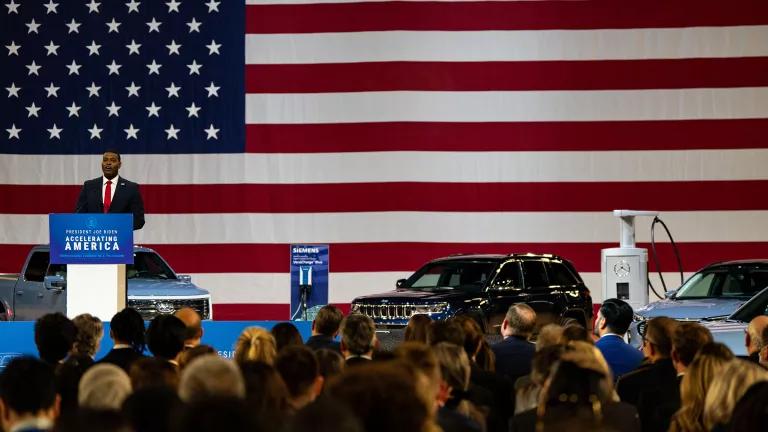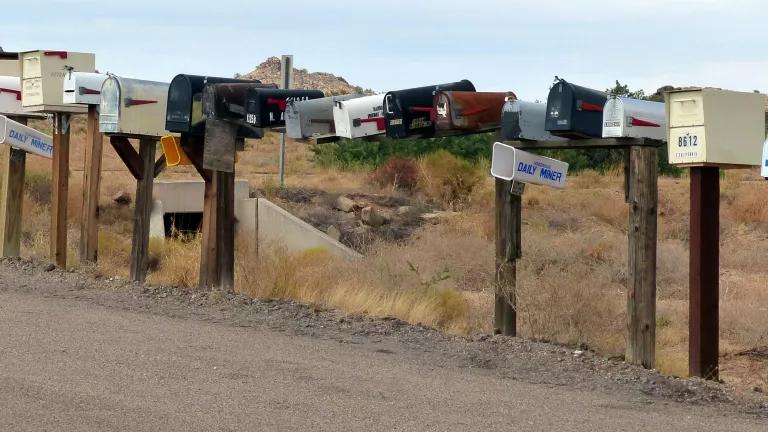EPA Reinstates States’ Ability to Curb Vehicle Pollution
This action is key to ensuring that clean vehicle innovation continues, regardless of who is in charge in Washington.

An aerial view of morning traffic on the 134 Ventura Freeway in downtown Glendale, California.
For more than 50 years, California and other states have protected their citizens from dangerous tailpipe pollution through standards that require new vehicles to get cleaner over time. In 2019, the Trump administration adopted unjust regulations that stopped states’ clean air efforts. The rules were flawed and illegal. The Biden administration is setting the record straight by reestablishing state authority to clean up vehicles.
The EPA today withdrew the faulty Trump rule and reinstated a Clean Air Act waiver that allows states to enforce vehicle tailpipe standards that are stronger than federal standards. This action is key to ensuring that clean vehicle innovation continues, regardless of who is in-charge in Washington.
States Are Clean Vehicle Innovators
The states are innovators and leaders in addressing tailpipe emissions that lead to smog, soot and climate change. The state standards have been key drivers in advancing the technologies to clean up gasoline cars and diesel freight trucks while also ramping up much-needed deployment of zero-emission electric vehicles.
Congress recognized this fact more than fifty years ago. In 1967, Congress enacted provisions in the Clean Air Act that allow California to set vehicle pollution regulations stronger than federal standards and, in 1977, that allow other states to adopt those California standards. Since then, these provisions have been used repeatedly to reduce dangerous air pollution in states.
Today, California and 16 states (New York, Massachusetts, Vermont, Maine, Pennsylvania, Connecticut, Rhode Island, Washington, Oregon, New Jersey, Maryland, Delaware, Colorado, Minnesota, Nevada and Virginia) representing about 40% of the US market have state clean car standards.
State standards are important nationally, too. As state standards have spurred commercialization of clean vehicle technologies, the federal government has often realized that these safeguards should be available to all Americans, and common-sense federal standards were put in place that followed the states’ lead.
Biden Administration Should Work with States on Bold National Standards
President Biden’s landmark and necessary goal to reduce carbon pollution by 50-52% by 2030 requires bold action to bring about a historic shift to zero-emitting vehicles.
New federal standards for passenger cars and light truck sales—built on those recently finalized for model year 2023 to 2026—should be adopted to achieve a 60% reduction in emissions on average by 2030 compared to 2021 new vehicles. The standards should also ensure that at least half of all sales in 2030 are zero emission vehicles to put the auto industry on path to 100% zero emission vehicle sales by 2035. Eliminating pollution from new vehicles within 15 years is critical for both improving peoples’ health right away and achieving net zero carbon emissions by 2050.
Governors of a dozen states called on the Biden administration to set standards to ensure all car sales are zero-emissions by 2035. California is developing standards that it and other states need now. Federal standards that keep up with the leading states will ensure cleaner cars and their ability to reduce consumer costs at the pump and fight climate change will be available to all Americans.
Strong standards are also the foundation to spurring investment by vehicle manufacturers, parts suppliers and infrastructure builders that will create jobs.
By reinstating the waiver, the U.S. EPA is recognizing the value of state leadership. Now is the opportunity for the federal government to partner with state leaders to accelerate the equitable and job-creating path to clean vehicles.




